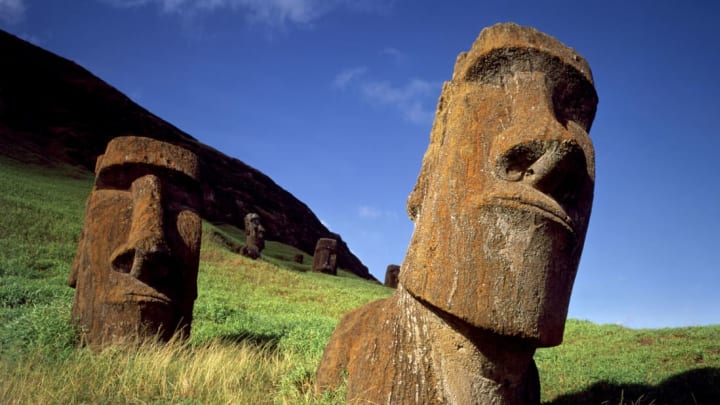Standing up to 33 feet high and weighing 81 tons, the huge moai statues of Easter Island (Rapa Nui) are the most recognizable artifacts of a thriving civilization that peaked at the middle of the last millennium. For hundreds of years, Polynesian peoples lived on the small island 2300 miles west of Chile and developed a complex culture. By the 1700s, when Europeans first arrived, much of the society was decimated.
For years, scientists thought they knew why—but fresh archaeological evidence has provided an alternative theory.
The Journal of Pacific Archaeology published a paper [PDF] this week contradicting the commonly held belief that, in the 1600s, Rapa Nui's inhabitants descended into a Lord of the Flies–like era of infighting and violence as a result of dwindling resources. According to new research, the island’s population may not have devolved into barbarism. Instead, they were collaborating on toolmaking.
University of Queensland archaeologist Dale Simpson, Jr. theorized that the raw materials used in the carving tools would reveal clues about the dynamics of the community. He and his colleagues collected 17 tools found near the moai, including axe-like toki. Using a mass spectrometer to analyze the chemical composition of the tools and samples from stone quarries on the island, Simpson and his colleagues found that most of the toki came from a single quarry.
Simpson believes this is evidence that Rapa Nui's people had not fallen into violent conflict, but were instead sharing resources—or at least allowing one another access to a favorite quarry for tool production. If the islanders were split into factions, it’s unlikely that whoever was controlling the quarry would permit rivals to make use of it.
If accurate, it would join other recent theories that are drawing a revised picture of Rapa Nui's civilization. Explorers once described a surplus of spear-like objects presumably used for combat, but modern researchers examining the tools (called mata’a) in 2015 found that their surfaces were too blunt to pierce skin and were probably used for tilling soil.
While Simpson's take on the newly discovered carving tools is an intriguing theory, researchers aren't ready to rewrite history just yet. Other scholars, including study co-author Jo Anne Van Tilburg, point out that raw materials for the tools could have been seized by force or some form of coercion.
More research will be needed to see if Simpson’s new theory holds up. If it does, it would present a new wrinkle in the storied history of Rapa Nui.
[h/t Gizmodo]
